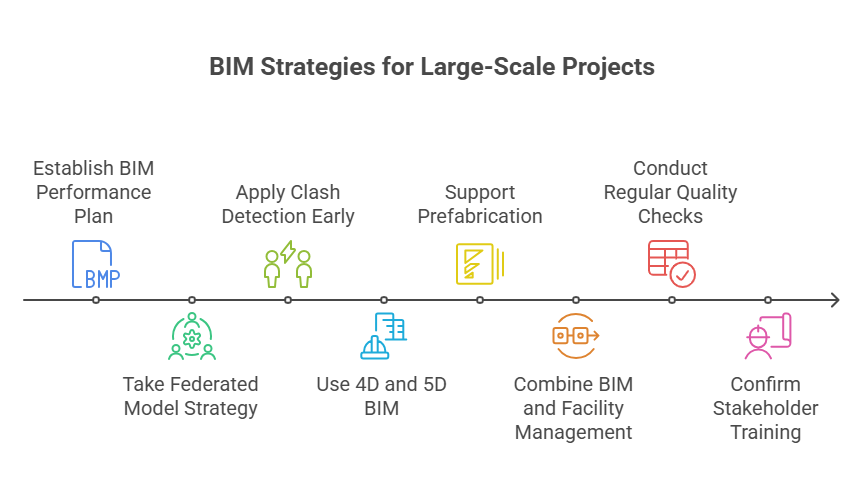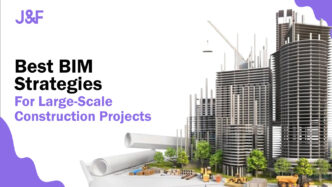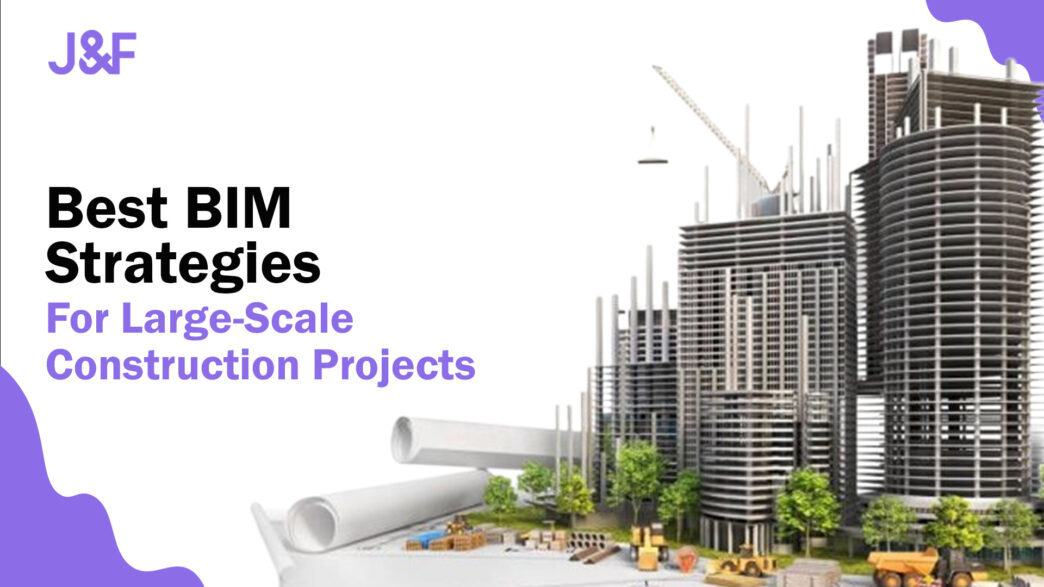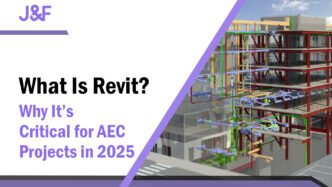As opposed to smaller counterparts, large projects cannot be managed with a free hand but rather with a professional approach and proper grasp of the related matters. In such scenarios, well-planned BIM strategies become essential. Bigger projects tend to become complicated without comprehensive control and know-how.
Building Information Modeling (BIM) is now an important component of the planning and execution of construction needed to address these challenges effectively.
Properly adopted, BIM strategies help avoid mistakes, improve productivity, and realize ROI to a considerable extent. The important point is to employ the proper approaches, which are specifically crafted to adapt to the size, scope, and objectives of your project. This blog will discuss the most effective BIM strategies in large construction projects, the effectiveness of BIM services, and how a professional BIM consultant can turn everything around.
The Importance of BIM Strategies in Large-Scale Projects
Major projects, involving a hospital, airport, stadium, or infrastructure development, involve the coordination of numerous disciplines. Such projects normally entail:
- Several design and engineering companies
- Strict deadlines, budgets
- Complex systems (HVAC, electrical, plumbing, structural, etc.)
- High regulations
A conventional 2D approach is not enough in that case. BIM services provide an interactive, three-dimensional, and digital modeling of the physical and functional aspects of the building, which helps in visualization, simulation, and collaboration in real time.
Best Large-Scale Projects BIM Strategies
Here are some of the most effective BIM strategies to implement in large-scale construction projects:

1. Establish a Clear BIM Performance Plan (BEP)
BIM BEP is like a map or plan of how BIM will be utilized during the project life. It defines:
- Project objectives and outputs
- Duties and functions
- Software and data transmission protocols
- Level of Development (LOD) expectations
- Collaboration guidelines
BEP ensures alignment of all the stakeholders with regard to expectations and, by so doing, prevents miscommunication in the future.
Pro Tip: You should employ a BIM consultant to design a BEP that fits your project-specific needs.
Need a custom BEP for your next project? Request a Quote now.
2. Take a Federated Model Strategy
In the construction of an extensive magnitude, it would be impractical to control all in a single model. Rather, divide the project into several discipline-specific models (architecture, structure, MEP) and put them together by way of a federated model integration strategy.
Such a plan will enable every team to work at its own pace but without bringing discord to the entire project. The federated model can then be imported into clash detection tools to identify and resolve conflicts early on, prior to the start of construction.
3. Apply Clash Detection and Coordination Early
Early clash detection is one of the largest money-savers in BIM. In large projects, there are thousands of components that interface in small spaces- this heightens the chances of spatial and functional clash. Early clash detection using BIM coordination tools such as Navisworks or Revit assists:
- Prevent expensive on-site rework
- Enhance scheduling accuracy
- Improve the integration of trades
Initial coordination gatherings, BIM consultants convened gathering, can be essential to coordinating teams and resolving complications before they develop into full-fledged problems.
4. Use 4D and 5D BIM Schedule and Cost Estimating
A 4D BIM relates the 3D model to time (scheduling), and a 5D BIM introduces data relating to cost. These dimensions are crucial in large-scale projects where timelines and funds are closely tracked.
Advantages of 4D/5D BIM:
- Better ordering of construction
- Picture of project milestones
- Successful budget forecasting
- Online cost and progress monitoring
The BIM services leaders will assist you in merging these dimensions to integrate proper management of resources.
Explore our comprehensive BIM services designed for large-scale construction.
5. Use BIM to support Prefabrication and Modular Building
Prefabrication is becoming fashionable among large projects to accelerate the construction and minimize waste. Accurate prefabrication can be performed, as the building components have precise geometry and specifications.
6. Combine BIM and Facility Management (FM)
BIM does not stop with construction. In the case of large-scale, commercial, and institutional facilities, facility management adds value in the long term when combined with BIM.
The BIM model is a digital twin of the building, and it aids:
- Track assets
- Control maintenance programs
- Renovate or enlarge the plans
- Enhance energy performance
An effective BIM strategy will make sure that your model contains the required metadata that you will utilize in operations and maintenance.
Let’s simplify your large-scale construction. Contact our BIM experts today!
7. Regular Quality Checks and BIM reviews should be conducted.
In a major project, the delay can be very costly due to any slight mistakes in the model. The audit and quality control of BIM models should not go amiss. These reviews may be routinely performed by BIM consultants to:
- Confirm the model accuracy
- Assure the use of standards (ISO 19650, etc.)
- Confirmation that LOD is complied with
- Determine any unresolved conflicts
This plan will serve to maintain quality in the project, and it will ensure products are delivered in line with what the client needs.
8. Confirm Stakeholder Training and BIM Literacy
The stakeholders should be able to operate the tools effectively to make the BIM strategy work. Invest:
- BIM educational courses
- Exclusive workplace training (Revit, Navisworks, and others)
- Joint model reviews
- A BIM-literate team makes better decisions and faster workflows.
A BIM Consultant Role in Strategic Implementation
A BIM consultant brings in-depth knowledge and impartiality to your project. They play a vital role in strategic BIM strategies that streamline project execution and ensure long-term success. Typically, a BIM consultant is responsible for:
- Towards Creation of the BIM Execution Plan
- Coordination of disciplines
- BIM tools and software work setup
- The practice of quality control and compelling platform checks
- Directing the project with ISO and BIM standards
Our certified BIM consultants are ready to guide your project—contact us now!
Conclusion
Building on a large scale requires not only manpower and materials but also hockey plans. Through proper BIM strategies, professional BIM services, and a full-time BIM consultant, you will enhance coordination and cut costs, and deliver more successful results from concept to completion. A strategic BIM approach is a financial decision and not a tech decision. The more intelligently you carry out BIM, the greater the profitability of your project.
Ready to implement proven BIM strategies for large-scale success? Get a free quote today.
FAQs
1. What is the major advantage of implementing BIM in vast construction?
BIM leads to greater coordination, minimization of errors, and efficiencies through the design, construction, and facility management phases. When combined with effective BIM strategies, it ensures seamless execution of even the most complex large-scale projects.
2. What is the role of a BIM Execution Plan in large projects?
A BEP harmonizes all stakeholders regarding the project targets, workflows, standards, and roles, to ensure no complications in collaboration and prompt delivery.
3. What does a BIM consultant do?
A BIM consultant ensures strategy development, implementation oversight, adherence to standards, and reviews of the models for quality control.
4. What are the advantages of 4D and 5D BIM to large projects?
4D BIM is an addition of data about schedule to BIM, and 5D is an addition of data about costs. Cumulatively, they enhance timeline visualizing, budgeting, and resource planning. When aligned with smart BIM strategies, they can significantly boost project efficiency.
5. Will there be any operations and maintenance of buildings that can use BIM after construction?
Of course, the BIM model is a digital twin of the building, which allows more effective monitoring of assets and maintenance, as well as the improvement of the building.







